John Glenn, First American To Orbit Earth, Dies At 95
Godspeed, John Glenn.
John Glenn, one of the original Mercury Seven and a pioneer in America’s space program, has died at the age of 95:
John Glenn, a freckle-faced son of Ohio who was hailed as a national hero and a symbol of the space age as the first American to orbit Earth, then became a national political figure for 24 years in the Senate, died on Thursday in Columbus, Ohio. He was 95.
His death was announced on Twitter by Gov. John Kasich of Ohio.
Mr. Glenn had recently been hospitalized at the James Cancer Center at Ohio State University in Columbus, though university officials said at the time that admission there did not necessarily mean he had cancer. He had heart-valve replacement surgery in 2014 and a stroke around that time.
He had kept an office on the campus at the John Glenn School of Public Affairs, which he helped found, and had a home in Columbus.
In just five hours on Feb. 20, 1962, Mr. Glenn joined a select roster of Americans whose feats have seized the country’s imagination and come to embody a moment in its history, figures like Lewis and Clark, the Wright brothers and Charles Lindbergh.
To the America of the 1960s, Mr. Glenn was a clean-cut, good-natured, well-grounded Midwesterner, raised in Presbyterian rectitude, nurtured in patriotism and tested in war, who stepped forward to risk the unknown and succeeded spectacularly, lifting his country’s morale and restoring its self-confidence.
It was an anxious nation that watched and listened that February morning, as Mr. Glenn, 40 years old, a Marine Corps test pilot and one of the seven original American astronauts, climbed into Friendship 7, the tiny Mercury capsule atop an Atlas rocket rising from the concrete flats of Cape Canaveral in Florida.
The Cold War had long stoked fears of nuclear destruction, and the Russians seemed to be winning the contest with their unsettling ascent into outer space. Two Russians, Yuri A. Gagarin and Gherman S. Titov, had already orbited Earth the year before, overshadowing the feats of two Americans, Alan B. Shepard and Virgil I. Grissom, who had been launched in separate missions only to the fringes of space.
What, people asked with rising urgency, had happened to the United States’ vaunted technology and can-do spirit?
The answer came at 2:47 p.m. Eastern time, when after weeks of delays the rocket achieved liftoff. It was a short flight, just three orbits. But when Mr. Glenn was safely back, flashing the world a triumphant grin, doubts were replaced by a broad, new faith that the United States could indeed hold its own against the Soviet Union in the Cold War and might someday prevail.
No flier since Lindbergh had received such a cheering welcome. Bands played. People cried with relief and joy. Mr. Glenn was invited to the White House by President John F. Kennedy and paraded up Broadway and across the land. A joint meeting of Congress stood and applauded vigorously as Mr. Glenn spoke at the Capitol.
In his political history of the space age, “…The Heavens and the Earth,” the author Walter A. McDougall described Mr. Glenn’s space mission as a “national catharsis unparalleled.”
“It seemed that he had given Americans back their self-respect,” Mr. McDougall added, “and more than that — it seemed Americans dared again to hope.”
Mr. Glenn was reluctant to talk about himself as a hero. “I figure I’m the same person who grew up in New Concord, Ohio, and went off through the years to participate in a lot of events of importance,” he said in an interview years later. “What got a lot of attention, I think, was the tenuous times we thought we were living in back in the Cold War. I don’t think it was about me. All this would have happened to anyone who happened to be selected for that flight.”
Mr. Glenn did not return to space for a long time. Kennedy thought him too valuable as a hero to risk losing in an accident. So Mr. Glenn resigned from the astronaut corps in 1964, became an executive in private industry and entered politics, serving four full terms as a Democratic senator from Ohio and in 1984 running unsuccessfully for the Democratic presidential nomination.
Finally, 36 years after his Mercury flight, in the last months of his final Senate term, he got his wish for a return to orbit. Despite some criticism that his presence on the mission was a political payoff, a waste of money and of doubtful scientific merit, the hero of yesteryear brought out the crowds again, cheering out of nostalgia and enduring respect as he was launched aboard the space shuttle Discovery on Oct. 29, 1998. At 77, he became the oldest person to go into space.
(…)
John Herschel Glenn Jr. was born on July 18, 1921, in Cambridge, Ohio, the only son of a railroad conductor who also owned a plumbing business, and the former Clara Sproat. A few years later, the Glenns moved to New Concord, a small town in southeastern Ohio with a population of little more than 1,000.
“It was small but had a lot of patriotic feeling and parades on all the national holidays,” Mr. Glenn once said. “Wanting to do something for the country was just natural, growing up in a place like New Concord.”
Like most everyone else there, the Glenns lived through the hard times of the Depression, instilling in their son a rigid moral code based on their own God-fearing example and saw him through an apple-pie boyhood. He played trumpet, sang in the church choir, washed cars for pocket money and worked as a lifeguard at a summer camp. In high school (now named for him), he was an honor student and lettered in football, basketball and tennis.
He still had time to court his high school sweetheart, Anna Margaret Castor, the doctor’s daughter. It did not matter that she stammered; she was his girl, and he loved her. They married in April 1943, and he often called her “the real rock of the family.” From the time they came to public attention, and throughout the turbulence of spaceflight and politics, John and Anna Glenn each seemed the other’s center of gravity.
Not until much later did she undergo intensive therapy that virtually cured her stammer, enabling her even to give speeches in public.
Mr. Glenn is survived by his wife; two children, Carolyn Ann Glenn of St. Paul and John David Glenn of Berkeley, Calif.; and two grandsons, Daniel and Zach Glenn.
Mr. Glenn began his journey to fame in World War II. In 1939, he enrolled at Muskingum College in his hometown to study chemistry, but he took flying lessons on the side. Shortly after the attack on Pearl Harbor on Dec. 7, 1941, he signed up for the Naval Aviation cadet program and after pilot training opted to join the Marines. As a fighter pilot, he flew 59 combat missions in the Pacific, earning two Distinguished Flying Crosses and other decorations.
Mr. Glenn saw more action in the Korean War, flying 90 combat missions and winning more medals. He put his life on the line again as a military test pilot in the early days of supersonic flight. In 1957, just months before the Soviet Union launched its first Sputnik satellite, he made the first transcontinental supersonic flight, piloting an F8U-1 Crusader from Los Angeles to New York in the record time of 3 hours 23 minutes 8.4 seconds.
Then, in 1959, newly promoted to lieutenant colonel, he heeded a call for test pilots to apply to be astronauts for the fledgling National Aeronautics and Space Administration. He and six other pilots were selected in April of that year. (The original Mercury 7 included Mr. Glenn, Mr. Shepard, Mr. Grissom, Walter Schirra, Gordon Cooper, Deke Slayton and Scott Carpenter.)
All seven men were eager, competitive and ambitious, but none more so than Mr. Glenn. Tom Miller, a retired Marine general and close friend since they were rookie pilots in World War II, recalled that Mr. Glenn was so determined to be an astronaut that he applied weight to his head to compress his height down to the 5-foot-11-inch maximum for the first astronauts. “He wasn’t going to miss a trick,” Mr. Miller said. “He’d be sitting down reading with a big bunch of books sitting on his head.”
But his determination did not win him the assignment to be the first American astronaut to fly. He had to wait out the suborbital flights by Mr. Shepard and Mr. Grissom in 1961 before his turn came.
In his 1999 memoir, written with Nick Taylor, he admitted he was sorely disappointed when Mr. Shepard was tapped for the first flight. As the oldest and most articulate of the astronauts, Mr. Glenn had attracted a big share of the publicity. He said that he had “worked and studied hard dedicating myself to the program” and that he thought he had a “good shot” at being first. In a letter to a NASA official, Mr. Glenn wrote, “I thought I might have been penalized for speaking out for what I thought was the good of the program.”
At this time, as Mr. Glenn often recalled, he never anticipated that his orbital flight would be the one that most excited the public, satisfying the nation’s hunger for a hero.
Tom Wolfe wrote of that time in the best-selling 1979 book “The Right Stuff,” a phrase for coolness in the face of danger that has passed into the idiom. He described Mr. Glenn as excessively pious, scolding his fellow astronauts about their after-hours escapades while openly lobbying to be the first of them to fly.
“He looked like a balding and slightly tougher version of the cutest-looking freckle-faced country boy you ever saw,” Mr. Wolfe wrote. “He had a snub nose, light-hazel eyes, reddish-blond hair and a terrific smile.”
Mr. Glenn said he liked the book but not the 1983 movie based on it, in which he was portrayed by Ed Harris. “Most of his account was reasonably factual, although I was neither the pious saint nor the other guys the hellions he made them into,” he told Life magazine in 1998. “Hollywood made a charade out of the story and caricatures out of the people in it.”
The 1962 space mission came after two months of one postponement after another, sometimes for mechanical problems, often for bad weather. Once Mr. Glenn had to wait six hours, fully suited, in the cramped Friendship 7 capsule before officials called off the launch. But he projected confidence. “You fear the least what you know the most about,” he said at the time.
On the 11th scheduled time, all was “go,” and the rocket lifted off from Pad 14 at Cape Canaveral. The flight stopped the nation in its tracks; people watched on black-and-white television, listened on the radio and prayed.
At the end of the first orbit, an automatic control mechanism failed, and Mr. Glenn took over manual control. He would see three sunsets in a brief time. He puzzled for a while about “fireflies” outside his window. NASA later determined that it was his urine and sweat, which was being dumped overboard and turned to frozen crystals glowing in sunlight.
A faulty warning light signaled that the capsule heat shield, designed to protect it in the fiery descent back to Earth, had come loose and might come off during re-entry. The signal was erroneous, but no one could be sure. Ground controllers ordered that a retrorocket unit attached under the heat shield by metal straps not be jettisoned after firing in order to give added protection and reduce the risk of premature detachment of the heat shield. This was Mr. Glenn’s first real clue that something was amiss.
As Friendship 7 plunged through the atmosphere, the astronaut’s recorded heartbeat raced as one of the metal straps came loose and banged on the side of the capsule.
“Right away, I could see flaming chunks flying by the window, and I thought the heat shield might be falling apart,” he wrote after the flight. “This was a bad moment. But I knew that if that was really happening, it would all be over shortly, and there was nothing I could do about it.”
The capsule splashed down in the Atlantic off the Bahamas, where a Navy destroyer was waiting. Mr. Glenn radioed, “My condition is good, but that was a real fireball, boy.”
One night in December 1962, Attorney General Robert F. Kennedy invited the Glenns to dinner at his home in McLean, Va. In the course of the evening, the attorney general suggested that Mr. Glenn run for public office. With the backing of a powerful Kennedy, he might have a good chance at a Senate seat from Ohio in the 1964 election.
Mr. Glenn’s parents happened to be among the few Democrats in New Concord, and Mr. Glenn once recalled that he had developed an abiding interest in political affairs from his high school civics teacher, Harford Steele.
Mr. Glenn eventually took the advice, but had to quit the race after being seriously injured in a bathroom fall. He spent the next decade working as an executive of the Royal Crown Cola Company. He still had the space itch, though, and inquired about a possible place on one of the Apollo missions to the moon, but NASA gave him no encouragement.
“Yeah, I would have liked to go to the moon,” he said in later years. “But I didn’t want to stick around being the oldest astronaut in training just hoping to go to the moon. So I went on to other things, and that was a decision I lived with.”
In 1970, Mr. Glenn ran again for the Senate, but lost in the Democratic primary to Howard M. Metzenbaum. Four years later, Mr. Glenn won the primary and breezed to victory in the general election, beginning a 24-year career in the Senate.
Over the years, Mr. Glenn earned the respect of Senate colleagues as an upright, candid and diligent legislator. Senator Bob Graham, Democrat of Florida, described Mr. Glenn as a “workhorse” who was especially well informed and a forceful voice on defense issues. “When he speaks, you know he’s speaking on a subject of which he has a command and a reason for speaking,” Mr. Graham said shortly before Mr. Glenn’s return to space.
As a senator, Mr. Glenn developed an expertise in weapons systems, nuclear proliferation issues and most legislation related to technology and bureaucratic reform. He generally took moderate positions on most issues, though in his last two terms his voting record became more liberal. He was an enthusiastic supporter of President Bill Clinton.
Glenn was part of the large group of Democrats who ran for President in 1984, but his campaign didn’t go very far notwithstanding the fact that he had far more star power than Walter Mondale and lacked the roving eye of Gary Hart. After dropping out of the race, Glenn stayed in the Senate until he retired in 1999. Shortly before he retired, Glenn became one of the oldest Americans, and one of only a handful of sitting legislators, to travel in space when he joined the crew of the Space Shuttle Discovery on a mission that lasted for nine days in October 1998. During that time, Glenn was reintroduced to a generation of Americans who knew of him mainly through history books and his political life.
Glenn was the last member of the Mercury Seven, the first group of astronauts sent by the United States into space, and while he wasn’t the first American to go into space, a distinction that would be given to fellow member Alan Shepard, he was the first to actually orbit the Earth, completing three orbits before his mission came to an end and he became an American hero. On a personal level, Glenn has always been among my favorite astronauts in part because I was given the assignment of writing a report on him in third grade. I don’t recall what I said, but it was part of the reason I became interested in the space program from that point forward. Several years later, when my family visited Washington, D.C. for the first time I actually got to meet Senator Glenn and shake his hand, which was a pretty cool thing for a ten-year-old. Somewhere in the plethora of family photographs, there’s a picture of that event.
Even with the end of the Shuttle Program, space travel has become somewhat more routine and most Americans have no idea who’s in space at any given time. In the early 1960’s, though, Glenn and the other Mercury Seven were as well known as rock stars, and when he returned to Earth he became the toast of a nation, receiving the requisite ticker-tape parade down New York City’s ‘Canyon Of Heroes’ and met with then President Kennedy, who would deliver his famous challenge to America to reach the Moon by 1969 just seven months after Glenn’s February 1962 mission.
NASA put it best on its Twitter feed.
We are saddened by the loss of Sen. John Glenn, the first American to orbit Earth. A true American hero. Godspeed, John Glenn. Ad astra. pic.twitter.com/89idi9r1NB
— NASA (@NASA) December 8, 2016
Indeed.
Update: Buzz Aldrin, who is still recovering from the respiratory issues that forced his evacuation from South Pole last weekend, remembers his fellow astronaut:
As I sit in hospital and just heard that my friend John Glenn has passed away, I feel fortunate to be recovering from my own illness, but saddened that we lost another space pioneer and world icon.
I first met John Glenn in 1953 when I was a fighter pilot in South Korea in the 16th squadron and the 51st fighter group. He was the Ops officer of the 25th squadron in the 51st fighter group. The next time I learned about him he flew of course on his first orbital flight and then when I reported as a NASA astronaut in 1963 and started training in 1964 we both became elders in the same church in Houston, TX.
Not long after that he left NASA and of course pursued a career in politics while I went on to do my Gemini 12 and Apollo 11 missions. When he was 77 he flew again on a shuttle mission and became the oldest to fly in space. I saw him at various memorials and astronaut gatherings over the years and I believe the last time we saw each other in person was at Neil Armstrong’s memorial at the National Cathedral although we spoke by phone and corresponded by email since then.
I was very saddened to hear the John was ill over the past year. Since he was the last remaining Mercury astronaut, I was always lobbying him to encourage the Apollo guys to do regular reunions annually since we’re not getting any younger. With the news today I’m saddened again to hear that we have lost the pioneer of space flight for the United States, second only to Yuri Gagarin, and he will always go down in history as certainly one of the most influential officers in the Marine Corps and of course as one of the original Mercury 7 astronauts. I am very sorry that he has departed us with his wisdom. I join that crowd of people and the entire nation and the world in paying homage to his service.
BUZZ ALDRIN
Aldrin. Armstrong Glenn. They don’t make many men like that.
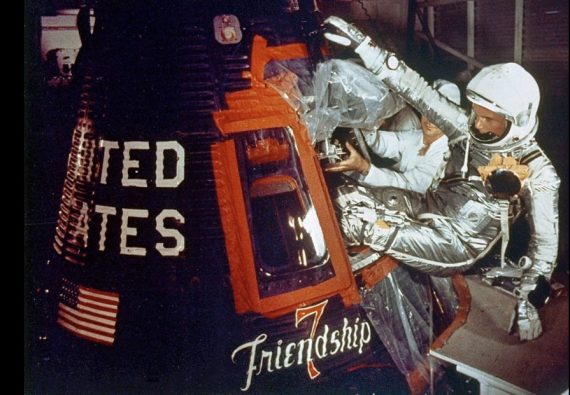

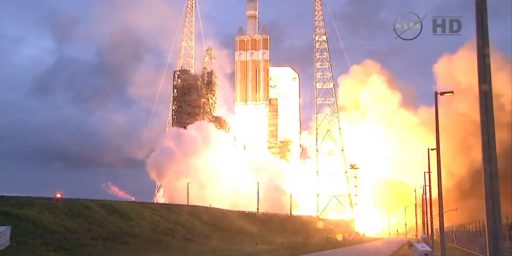
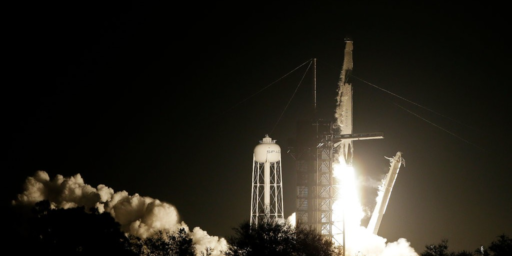
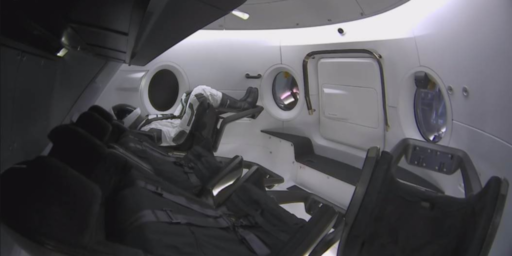
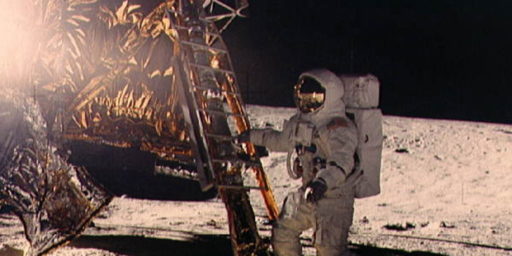
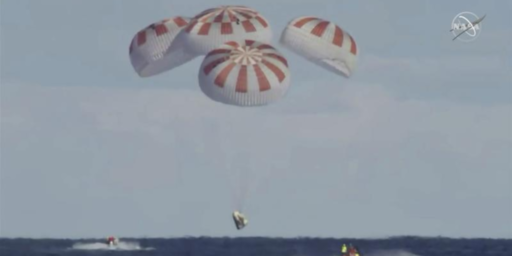
I remember the launch. The countdown, then the liftoff and the announcer saying those words, “Godspeed, John Glenn.” It was thrilling and quite moving.
His rectitude, courage, and honor shines as brightly as the stars. Our nation is better for his works.
A fine man and astronaut who lead a consequential life.
A long life, gloriously led.
Wait, a white Midwestern Presbyterian war veteran and Democrat?….why just the guy a few of you schitt on during the election when the insipid wr inter alia argued “who cares about the white vote?”
A true, humble man, just like his fellow astronaut and Ohioan Neil Armstrong.
May they both RIP.
The last knight of Camelot has died, bringing to end an era.
Who are our heroes, now?
@Guarneri:
… well said … he lived a golden life
@Liberal Capitalist:
Donald Trump.
As I said in the other thread; Glenn was a heroes, hero.
RIP, sir.
I’ll get lambasted for this…but it bears saying.
1962, when Glenn orbited the Earth, the top tax rate was 91%. We were just beginning to explore space and would, just 7 years later, land on the moon. We were 6 years into building the Interstate highway system.
Today, we could not do any of those things. Today we proudly ignore science. Today we cannot build anything, because tax cuts.
Trump promises to bring back those halcyon days while cutting even more from today’s highest rate of 39%.
And 46% of this country is stupid enough to believe him.
@C. Clavin: I’ll get lambasted for this…but it bears saying.
Nailed it. We have a president elect who says that climate change is a Chinese hoax, who makes up his own numbers whenever it suits him, who seems to think that taxes are for the little people.
“1962, when Glenn orbited the Earth, the top tax rate was 91%”
Except it wasn’t. With deductions the effective tax rate was much lower, but high enough to draw the ire of a certain JFK.
“We were just beginning to explore space and would, just 7 years later, land on the moon. We were 6 years into building the Interstate highway system.
Today, we could not do any of those things.”
Because the left overstepped their bounds and started taking money from some people and giving it to others, instead of actually doing things. It should surprise no one that those most adept at working the system did best.
“Today we proudly ignore science.”
Only junk science. And you wouldn’t know science if it bit you in the arse.
@Guarneri:
Sure and the effective tax rate now is far less than 39%.
The Cheeto Jesus doesn’t pay taxes.
What’s your point?
@Guarneri:
Yeah…junk science 100% of qualified scientist endorse…you stupid phuck.
@Guarneri:
We have low marginal tax rates which gives the lie to that extremely stale and factually questionable assertion.
Speaking of overstepping their bounds: George W Bush cut taxes – giving money to upper middle and upper class taxpayers – while starting and waging a multi-year, multi-trillion dollar war in the Middle East?
I see we should have closed the comments section on Thursday at 19:22. Oh well…
@C. Clavin:
As noted, this was a marginal rate that no one paid. In 1962, the feds spent 17% of GDP. Today they spend 21%. Peddle your garbage in some more appropriate thread.
@Hal_10000:
According to conservatives the economy is still stagnant, while 1962 the economy was booming.
Additionally, life is far more complex in the requirements that we expect of government. Especially with massive military spending, over which we have no real control, pointing out that Eisenhower was right.
So, with this in mind, you are saying that there is a 4% increase in 50 years.
Compare the price of a 1962 car with a 2016 car? Has that only increased 4%? How about homes?
If this is an example of out-of-control spending, it’s weak sauce.
@Liberal Capitalist:
Well, that was a whole lot of nuthin’. In 1962, a car cost about $3k or the equivalent of $24k today. What’s your point?
In 1962, half the budget was spent on national defense (approximately 8% of GDP) because we were in a Cold War and ramping up Vietnam. Today it’s about 3% of GDP. Again, what’s your point? (And I think defense spending should be cut)
In 1962, our economy was about to go through the Great Inflation, a Keynesian idea that would rob all the GDP growth of any meaning. And the economy was great … if you were a white man. Again what’s your point?
@C. Clavin: I would like to see President Obama put some challenges out there similar to what President Kennedy did with the space program.
A working fusion electrical generating plant by 2017.
A rover mission to Venus. Let’s get some exploring going on there.
A manned Mars mission by 2025.
Rebuild and modernize the electrical grid.
Vice President Biden gave a challenge of curing cancer. That is the spirit we need. A recent amazing announcement was made that a new rocket engine (em engine) that can reach Mars in a jaw dropping ten weeks ! Now that is what we’re talking about.
If this country can put a man on the moon, it can do just about anything.